Questões de Vestibular UEMA 2021 para Vestibular - 1º Dia
Foram encontradas 44 questões
ARANHA, Maria Lúcia de Arruda e MARTINS, Maria Helena Pires. Filosofando: introdução à filosofia. São Paulo: Moderna, 2013,
Sentidos e razão se apoderam dos objetos, respectivamente, por
https://brainly.com.br/tarefa/1416322
Quando os valores são naturalizados em uma sociedade e perdemos a origem deles, temos dificuldade para
Analise o seguinte argumento.
Se um grande número de As foi observado sob ampla variedade de condições, e se todos esses As observados possuíam, sem exceção, a propriedade B, então todos os As têm a propriedade B.
Tome-se como exemplo para o enunciado acima o ponto de ebulição da água. Sempre que observamos a água ferver (A), isso aconteceu a 100 graus centígrados (propriedade B). Portanto, pode-se concluir que a água (A), e, qualquer água encontrada na terra, ferve a 100 graus centígrados (propriedade B).
https://filosofianaescola.com/logica/argumento-indutivo
Como é classificado esse tipo de argumento?
A mais recente constituição garante os direitos civis, políticos, econômicos, sociais e culturais dos nossos cidadãos. Essas garantias aparecem, por exemplo, logo no primeiro artigo, onde é estabelecido o princípio da cidadania, da dignidade da pessoa humana e os valores sociais do trabalho. Já, no artigo 5º, é estabelecido o direito à vida, à privacidade, à igualdade, à liberdade e a outros importantes direitos fundamentais, sejam eles individuais ou coletivos.
https://www.politize.com.br/direitos-humanos-no-brasil/
Ter legitimidade de direitos não significa ter ausência de conflitos sociais. Entre os regimes políticos, aquele que considera o conflito social como legítimo é conhecido como
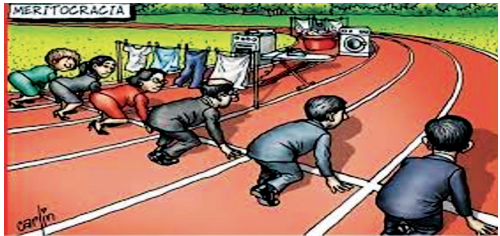
https://www.facebook.com/vivirconinteligenciaemocional/photos/meritocracia-y-punto-de-partida/2141736749218531
O problema social evidenciado na charge é explicado pelo conceito sociológico de
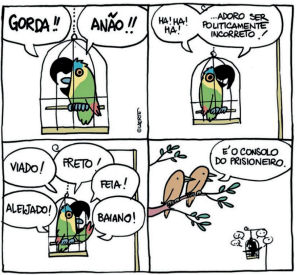
https://www.revistacontinente.com.br/edicoes/184/humor-grafico-em-questao
Analise as assertivas quanto aos preconceitos exteriorizados na charge.
I) opinião fixamente formada sobre uma pessoa, grupo ou cultura, sem levar em conta os fatos que a contestam, sendo um julgamento prévio baseado em estereótipos depreciativos. II) classificação dos seres humanos conforme suas características físicas, econômicas e sociais, destacando negativamente aqueles que se apresentam mais próximos aos padrões impostos pela sociedade. III) generalização das diferenças individuais, visando à construção de uma identidade coletiva homogeneizadora, pautada em caracteres representativos das maiorias sociais. IV) naturalização de estigmas construídos socialmente, difundidos nos processos de socialização, sendo interiorizados, enraizados e repetidos de forma acrítica por aqueles que se acham superiores.
Estão corretas, apenas, as assertivas
Família
Família Família, família Papai, mamãe, titia Família, família Almoça junto todo dia Nunca perde essa mania Mas quando a filha quer fugir de casa Precisa descolar um ganha pão Filha de família se não casa Papai, mamãe não dão nenhum tostão Família êh! Família ah! Família Família, família Vovô, vovó, sobrinha Família, família Janta junto todo dia Nunca perde essa mania [...]
https://www.letras.mus.br/titas/48973/
Analise as categorias sociológicas a seguir e relacione-as com as características de família, apresentadas na canção.
I) Ocupações sociais - referem-se às posições ocupadas na sociedade, associadas a diferentes graus de prestígio, poder, direitos e deveres, definindo as responsabilidades e os privilégios de cada pessoa. II) Instituições sociais - compõem o conjunto relativamente estável de padrões culturais sancionados coletivamente para moldar os indivíduos, regulando a vida humana. III) Ações sociais - dizem respeito à expectativa da maneira como os indivíduos devem agir e se comportar, orientando os relacionamentos sociais e afetivos. IV) Grupos sociais - constituem como um grupo de pessoas que compartilham certos valores, crenças, costumes, pautados em relações pessoais ou impessoais, segundo o tipo de grupo, criando laços sociais.
A relação correta está contemplada, apenas, em
Em 2012, início da série histórica do IBGE para a medição, o rendimento médio mensal dos brancos foi 57,3% maior que o dos negros. Em 2019, quase nada havia mudado: a população branca recebeu, em média, 56,6% a mais que a população negra. [...] Os números também mostram que as pessoas negras ainda ocupam postos de trabalho mais precários. Os dados mais recentes, de 2015, revelam que os negros eram maioria em atividades braçais como cultivo de mandioca (85,9%), serviços domésticos (64,7%) e construção civil (63,9). Por outro lado, eles são minoria em áreas que exigem maior qualificação como informática (31%), arquitetura e engenharia (26,9%) e em cargos de gestão empresarial (23,6%). [...] Pequenos avanços Um dos artigos do Estatuto (da Igualdade Racial), ressaltado pelos especialistas, é o que trata da adoção de ações afirmativas para acesso ao ensino superior e ao trabalho. "A cota é a única política em vigor no Brasil para reverter esse círculo vicioso que mantém a população negra em uma posição inferior", afirmam os especialistas. Os resultados da política de cotas já podem ser observados. Dados do IBGE mostram que a presença de negros nas universidades dobrou entre 2011 e 2019, passando de 9% para 18%. Os números são referentes a estudantes que frequentam o ensino superior na idade adequada, entre 18 e 24 anos. "Ainda vemos uma grande desigualdade, mas já há um avanço tímido". As cotas raciais enfrentaram - e ainda enfrentam - uma grande resistência entre os brasileiros. [...] Mais uma vez, é o racismo se manifestando.
Brancos continuam recebendo 50% a mais do que negros no Brasil. 20/07/2020. Disponível em:< https://economia.uol.com.br/noticias/estadao-conteudo/2020/07/20/abismo-economico-entre-brancos-e-negros-persiste.htm (Adaptado).
A afirmação do sociólogo Florestan Fernandes sobre a sociedade brasileira que tem poder explicativo para os dados apresentados no texto acima é a de que
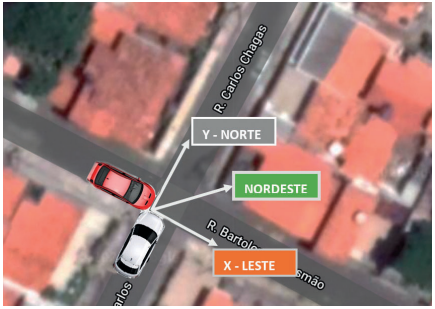 https://earth.google.com/web/search(Adaptada)
https://earth.google.com/web/search(Adaptada)
Um carro com massa de 1600 kg que se deslocava de oeste para leste, com uma velocidade de módulo igual a 72 km/h, colidiu com uma caminhonete de massa igual a 2400 kg que se deslocava do sul para o norte, com uma velocidade em módulo de 36 km/h. Em virtude da colisão, os dois veículos seguiram engavetados como um único corpo, na direção nordeste.
https://imirante.com/oestadoma/noticias/2015/07/09/550-acidentes-de-transito-ocorrem-por-mes-em-avenidas-de-sao-luis/ (Adaptada)
Considerando a situação descrita acima e que, no momento da colisão, estava chovendo muito e, por isso, o atrito entre os veículos e a estrada pode ser desprezado, o módulo da velocidade, no momento em que os dois veículos movem-se juntos, na direção nordeste, em m/s, é igual a
Ela foi construída em 1889, em Paris, como parte das comemorações do centenário da Revolução Francesa. Inaugurada, em março de 1889, a torre Eiffel, ou “Dama de Ferro”, como ficou conhecida na época, comparada às pirâmides do Egito por seu idealizador, possui 7 mil toneladas de ferro e 3 mil toneladas de materiais variados, e levou só dois anos para ficar pronta. A construção foi um enorme desafio para a engenharia da época porque possui 300 m de altura e fica 15 cm mais alta no verão, devido à dilatação térmica do ferro. No seu topo, tem várias antenas de rádio cuja esfera de aço de cada antena tem raio de 10 m para garantir estabilidade contra ventos fortes. No verão parisiense, essas esferas sofrem uma variação de 5,04 m3 quando a temperatura chega a 30°C.
https://super.abril.com.br/mundo-estranho/como-foi-construida-a-torre-eiffel/(Adaptada)
Uma das esferas da antena de transmissão no topo da torre precisa ser substituída por outra, de mesmo material, cujo volume é 250 m³ a 2 °C. Qual a variação de volume, em m³, dessa esfera quando a temperatura chegar a 42 °C? Considere π=3
Para um exame do tórax, o campo magnético necessário é 1,5 T produzido por uma corrente elétrica de 20 A. Qual é o número de espira, por centímetro, nesse tubo para a realização desse exame? Considere µ = 1,25.10 -6 T.m/A
A alta dose de radiação tem a função de promover várias mutações no DNA e/ou RNA dos vírus, levando-o à morte ou impedindo que ele se reproduza. A luz UV é eficaz para inativar bactérias e vírus nas faixas de UV-B e UV-C com onda de comprimento entre 200 a 310 nm (nanômetros).
https://www.uol.com.br/tilt/noticias/redacao/2020/08/07/para-anvisa-nao-ha-certeza-de-que-raios-ultravioleta-destroem-coronavirus.htm (Adaptada)
Sabe-se que a radiação eletromagnética (ou simplesmente, a luz) é quantizada, segundo Einstein, e a quantidade elementar de luz, hoje, recebe o nome de fóton. Por isso, para eliminar o vírus sobre a superfície, uma rede de supermercado instalou cabines UV para descontaminar os carrinhos de compras. A cabine contém luz ultravioleta com comprimento de onda de 300 nm.
Qual a energia desse fóton em elétrons-volts?
Adote a constante de Planck = 4,14.10-15 eV.s e a velocidade da luz de 3,0.108 m/s
A probabilidade de que seja homem um apoiador do candidato A, selecionado ao acaso, é

As distâncias d¹ e d², em metros, do ponto de içamento em relação aos menores lados desse triângulo para que a peça seja içada exatamente pelo ponto de encontro das três medianas são iguais a
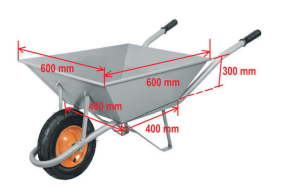
Quantos volumes desse carrinho de mão, completamente cheios de terra, serão necessários para transportar 1,90 m³ de areia?
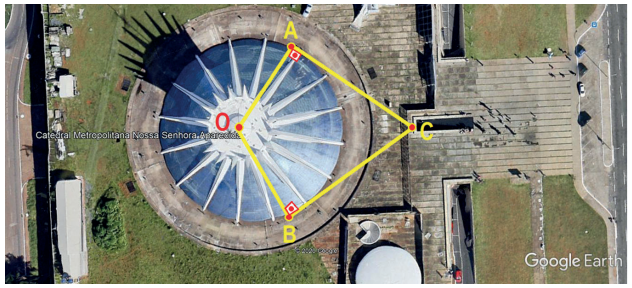
Um turista localizado no ponto C observa dois trabalhadores nos pontos A e B numa trajetória retilínea a x metros de distância de cada um. Sabendo que o arco AB é de 3 π/4 metros, nessas condições, o valor de x, em metros, é
Analise os esquemas que representam diferentes fases da divisão celular por meiose.
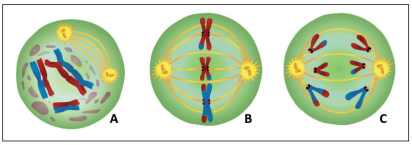
https://www.infoescola.com/citologia/meiose
Os esquemas A, B e C correspondem, respectivamente, às fases de
A proteção vacinal da poliomielite, no Brasil, está sofrendo queda brusca. De janeiro a julho de 2020, a cobertura atingiu 60% do público-alvo, muito abaixo dos 95% preconizados pela Organização Mundial da Saúde (OMS). O distanciamento social e o medo causado pela pandemia da Covid-19 são listados como as causas do declínio. Os números preocupam médicos que temem um novo surto da doença já erradicada no país. A integrante do Departamento de Infectologia da Sociedade Brasileira de Pediatria afirma que, atualmente, há mais de 1 milhão de crianças inadequadamente vacinadas. A poliomielite é uma doença grave que pode causar paralisia e atrofia dos membros e sua evolução pode levar à morte. Apesar de ser predominante entre as crianças com até 5 anos de idade, ela também pode afetar adultos.
https://www.metropoles.com/saude/poliomielite-volta-a-preocupar-em-cenario-de-queda-na-vacinacao
Em relação à poliomielite, é correto afirmar que se trata de uma patologia
LOPES, Sônia; ROSSO, Sérgio. BIO: volume único. 2.ed. São Paulo: Saraiva, 2013.
Pode-se afirmar que os insetos têm desenvolvimento
I. ametábolo, direto, sem metamorfose. Do ovo eclode um indivíduo jovem semelhante ao adulto. Exemplo: traça-dos-livros. II. hemimetábulo, indireto, com metamorfose incompleta. Do ovo eclode uma ninfa semelhante ao adulto, mas não tem asas desenvolvidas. A ninfa origina o adulto. Exemplo: percevejo. III. holometábulo, indireto, com metamorfose completa. Do ovo eclode uma larva distinta do adulto, passa por uma fase de pupa, podendo formar casulo. Daí ocorre a metamorfose onde a larva se transforma no jovem que emerge completamente formado e origina o adulto. Exemplo: moscas.
Estão corretas as seguintes afirmativas:
Analise o ciclo a seguir.
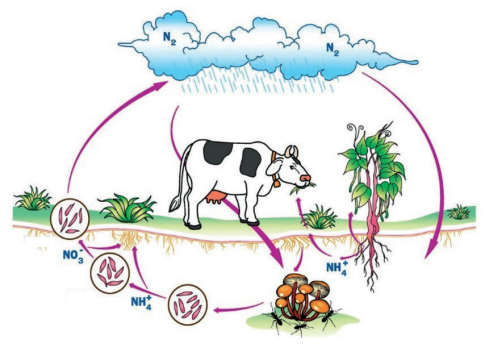 LINHARES, Sérgio; GEWANDSZNAJDER, Fernando. Biologia. V. 3. São Paulo: Ática, 2014.
LINHARES, Sérgio; GEWANDSZNAJDER, Fernando. Biologia. V. 3. São Paulo: Ática, 2014. Durante as etapas do ciclo do nitrogênio ocorre